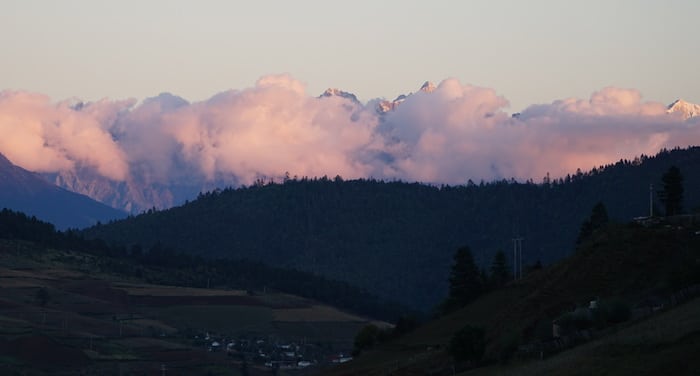 The mountains at sunset between Lijiang and Shangri-la -Photo by Matteo Bosi
The mountains at sunset between Lijiang and Shangri-la -Photo by Matteo Bosi
Wrapped in the mountains on its high plateau, protected by the imposing Jade Dragon Snow Mountain, Lijiang (丽江) is an ancient city whose original nucleus goes back over 1000 years, when the Ancient Tea Road (or Southern Silk Road) transited here, attracting merchants from all over Asia.
The Naxi were firmly established here at the time, shaping a center that today is a renowned tourist destination. The ancient heart is surrounded by a modern city that today flaunts luxury hotels, a capacious theater and wide streets to allow the numerous crowds of tourists to appreciate the tiled ways of the historic center, curled roofs and products typical of the area.
Lijiang is an unmissable stop on a classic Yunnan itinerary; while with a little more effort you can get to Shangri-la, for sure Lijiang isn’t missed by the Chinese visiting this region. As a result it’s a very popular city filled with bodies.
The Naxi themselves, who once lived in these alleys and ran their businesses there, now have almost completely abandoned the place, leaving the business to the Han. What was a precious architectural and social jewel, is now in their eyes an open mall, where the streets are packed with colored lights and there’s too much noise.
If you can, have a Naxi take you around the city: he’ll tell you how things once were a few decades ago, before the earthquake devastated the city and the homes were in their original forms; when from the boxy square you could freely romp through the local alleys; when the locals all knew each other and each street had a specific commercial interest.
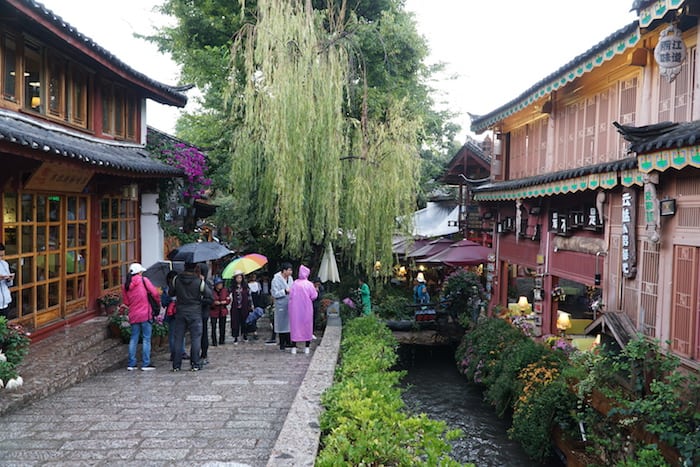 A street in Lijiang on a rainy day – Photo by Matteo Bosi
A street in Lijiang on a rainy day – Photo by Matteo Bosi
When to go to Lijiang
Embraced by the mountains and protected by the majestic Jade Dragon Snow Mountain, Lijiang on its plateau is moderately cold in winter and just as moderately hot in summer.
Lush due to the frequent rains of the hot season, it’s a sunny place during the rest of the year at 2.400 mt. of altitude. So, there’s no specific time to visit here, but rather a time to avoid: that’s a hard no to the Chinese national holidays. It’s best to go in the “anytime” periods, which will allow you to peacefully enjoy the historic center and its maze of alleys.
If you can choose, the shoulder seasons are always the most pleasant. Only, as a general rule, at night it gets much colder than during the day, so it’s best to sleep all bundled up.
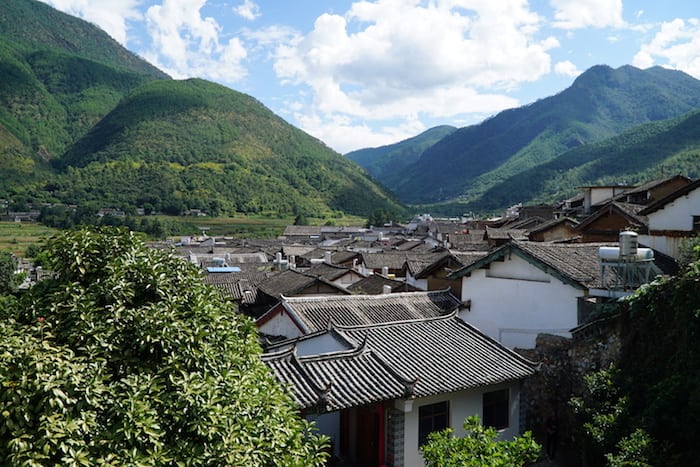 The roofs of a Naxi village – Photo by Matteo Bosi
The roofs of a Naxi village – Photo by Matteo Bosi
How to get to and get around Lijiang
Aside from a few Asian cities like Taipei or Kuala Lumpur, there are no direct flights that fly to Lijiang from abroad, so you’ll usually have to stop in one the various Chinese cities that offer this route. Besides the big cities (Beijing, Shanghai, Nanjing, Hangzhou, Guangzhou), on the list there’s: Xi’An, Wuhan, Shenzhen, Nanning, Lasha, Guilin, Chengdu and Chongqing and others.
For domestic flights within Yunnan you can count on, those from Kunming, Xishuangbanna and Pu’er. There aren’t any flights between nearby Shangri-la and Dali (which are served by trains and other wheeled means).
Lijiang’s airport is called Sanyi International Airport and is 30 km from the historic center. There’s a shuttle bus service (机场巴士市区线) which leaves outside of departures (exit 2) and, without making any stops, goes as far as the Lantian hotel (蓝天宾馆), where you’ll need to take a taxi to get to the old city.
The shuttle bus costs 20 Yuan while a taxi from the hotel to Lijiang Old Town about 15 Yuan. A taxi ride from the airport to the old city varies between 100 and 120 Yuan (180 Yuan at night).
It will take a little more than an hour if you use the bus, 45 minutes if you use the taxi. The shuttle bus runs from 6.30 to 22.00; its frequency is every half hour going to the airport, while the opposite way the service begins and ends according to the flight times. Tickets are bought on board.
If you’re traveling to or from Dali (大理), you can take one of the seven daily K (express) trains for a two hour ride. For Shangri-la, there are only cars or long distance buses – from the Lijiang bus station, every day between 7.30 and 17.00 a bus leaves every 40 minutes for a 4 hour direct ride to Shangri-la; a ticket costs less than 60 Yuan.
The old city of Lijiangis easily visited on foot, even if it is a nice walk that, counting stops and photos will take a whole day. You can rent bicycles, various hotels have them. The city’s layout is made up of a network of alleys that are centered toward the main square Si Fang Jie (四方街). To the north of the old city is the Black Dragon Pool Park.
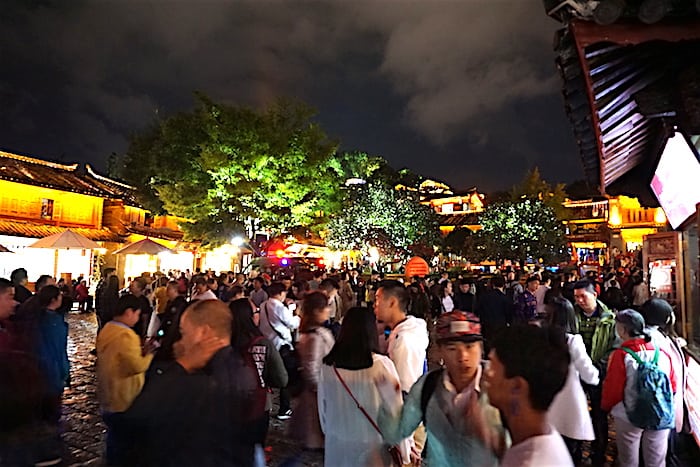 Lijiang Old Town at night during a National Holiday – Photo by Fabio Andreetti
Lijiang Old Town at night during a National Holiday – Photo by Fabio Andreetti
Where to stay in Lijiang
There are various types of buildings within the small Naxi houses in the center. Its pointless to say that you can live like a king in five star lodging for moderate prices: Yunnan is still a rather cheap area. Staying in the new city is another practical option, since the two centers are adjacent and each are well-served.
Click here for the best lodging options in Lijiang.
What to see in Lijiang
Lijiang Old Town (丽江古城): the historic center is called by this name to distinguish it from the modern agglomeration that surrounds the old castrum. According to UNESCO there are three centers, all equally inscribed on the World Heritage List, that make up Lijiang: the most famous is Dayan Old Town (大研古城). The second center is Shuhe (束河古城), 4 km from Dayan. This too is popular with tourists. For a more genuine visit it’s best to go to Baisha (白纱古城) – see the following -. Or, as a rule that goes for all three of these pearls of Yunnan, built by ethnic minorities, get up early and visit the city when the majority of tourists are still asleep.
The Lijiang Old Town that you see has been rebuilt after the earthquake of 1996, although they’ve faithfully kept to the Naxi style: the ground floor is reserved for business while the family lives on the upper floor. The homes are largely of wood, the roofs covered by tiles with curved points; the largest are built around an interior courtyard and marked by imposing, beautifully decorated entrances.
As the name suggests, Dayan, the big inkwell, is full of canals where the water drains from the mountains and valleys. Lijiang in fact is famous for it’s extraordinary water system that not only regulated the flow, but the city’s use of the springs: three tanks alternate along the sides of the streets, one for potable water, one for washing the vegetables and one for washing clothes, to be rigorously used for these purposes in order from high to low. Don’t miss the bridges, most of all Wanzi (万子桥), which was built in sand to wish the city a future of prolific offspring.
- Mu family residence (木府) and Pagoda Wanggu (望古楼): among the various Naxi residences , Mu Mansion is known for its size and its faithful reconstruction. The Mu family governed Lijiang for about four centuries on behalf of the Ming, so what remains of their home is an example of the richness of the time. It’s worth a visit along with Wanggu Pagoda, connected to it: from the top of the tower you can get a wonderful view.
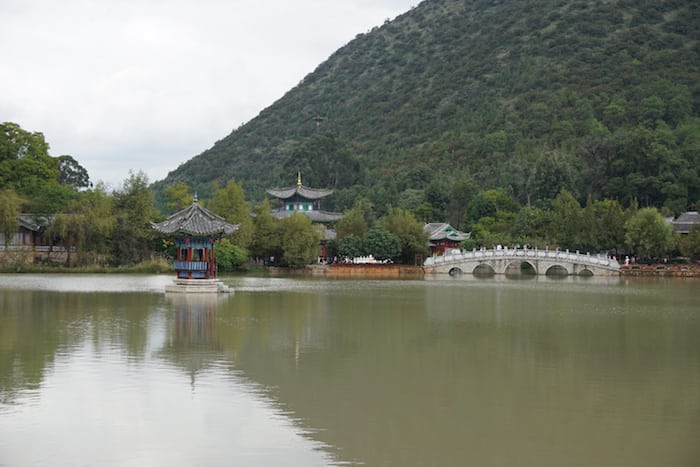 Black Dragon Pool – Photo by Fabio Andreetti
Black Dragon Pool – Photo by Fabio Andreetti
- Black Dragon Pool (黑龙潭): this is an easy stroll where you can seek out a view of the lake that is perfectly set at the foot of Elephant Hill; obviously its better on sunny days. Black Dragon Pool Park, north of the old city, is well-maintained but a bit overrated…
Dongba Museum (东巴博物馆): the museum is adjacent to the Black Dragon Pool. The term Dongba refers to an animist type religion of many of the Naxi. Several of the Dongba traditions are still practiced and the museum illustrates not only the rites of the Dongba priests, but also a reliable photographic record on the entire Naxi culture. In particular, I suggest you spend some time looking at the writing system: an extraordinary pictographic system that’s incredibly similar to other more well-known hieroglyphics!
Note: don’t be taken in by the Naxi village near the museum, because this is not at all an original village but a tourist reconstruction (or “money making machine”). A few Naxi work onsite, recounting their culture, but usually these mega theme parks in China are full of scams…
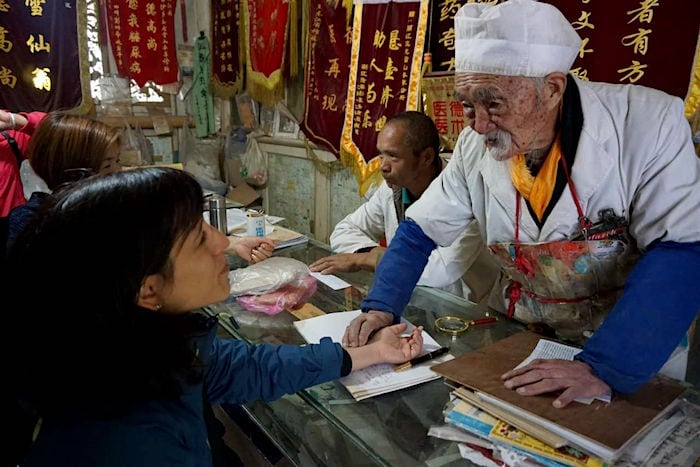 Doctor Ho while he visits me – Photo by Fabio Andreetti
Doctor Ho while he visits me – Photo by Fabio Andreetti
Just outside of old Lijiang, reachable by a short car or public transportation ride, there are a few other points of interest in the area.
- Jade Dragon Snow Mountain (玉龙山): a monster that goes well over 4.000 mt. with views from the “roof of the world”. Entrance to the park isn’t cheap (120 Yuan) and the cable cars have a separate fee (180 Yuan for the most expensive). The highest peak, Sanzidou, is covered by snow all year long, so excursions to the top are for fans of mountaineering and glaciers. Actually, you get close to the peak via zip line, the highest in the world, and up top there are various stairs to help with the climb. Moreover, other cable cars connect the valleys to the “smaller” peaks, under 4.000 mt. The park can be reached from Lijiang via bus number 7 (15 Yuan, an hour’s time), but its more convenient to rent a car that will allow you to reach the site entrances and cable car departures inside the park. These mountains form one of the slopes of the Tiger Leaping Gorge.
Baisha Old Town (白纱古城): this Naxi center is an adorable village a little less overwhelmed than Lijiang, but just as interesting. It can also be reached by bicycle because it’s only 7 km away, but there are various cars that shuttle between them and wait for tourists at the end of the visit. What you should absolutely not miss in Baisha is the mural, the only one still intact, which survived all attempts to annihilate the Naxi heritage over the course of history by the various Chinese governments. The mural is a testament to multiculturalism, tolerance, coexistence and peace without equal in our day: the picture gathers Han, Tibetan and Naxi characters, celebrating the harmony. It isn’t a “beautiful” creature as much as a symbol of how the ethnic groups lived together harmoniously. There’s an entrance fee to the village (30 Yuan).
In Baisha there lives, and I wish him luck and many more years, a Chinese doctor in his nineties, Doctor Ho. A human archive of national historic memory that has met and cared for celebrities from around the world, and proudly keeps testimonies of his encounters: magazine and newspaper clippings, thank you letters, photographs, in his hovel next to a canal in Baisha where for decades he personally prepares the medications he offers to his patients. Together with his son, you can visit for free for advice on buying their offerings. Ask anyone, they’ll easily give you directions.
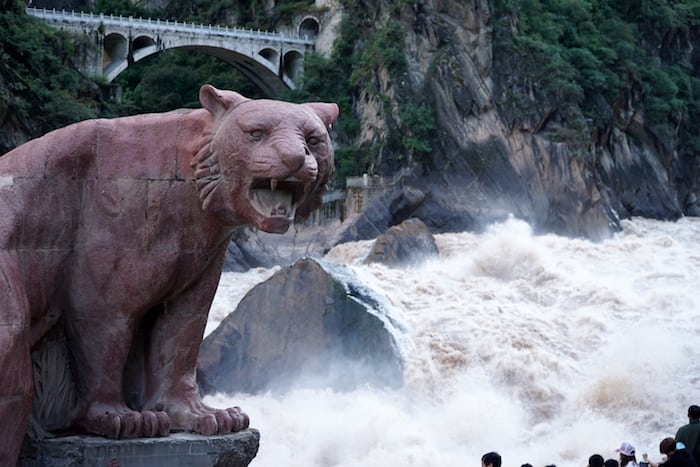 The statue of a tiger at Tiger Leaping Gorge – photo by Matteo Bosi
The statue of a tiger at Tiger Leaping Gorge – photo by Matteo Bosi
Tiger Leaping Gorge (虎跳峡): 80 km north of Lijiang, is one of the most famous places in Yunnan, Tiger Leaping Gorge. There the Yangze is bottled into a canyon that is among the deepest on Earth, watched over by the imposing heights of Jade Snow Mountain that holds it at its smallest point, in thirty meters of fast and thunderous rapids. The name comes from the legendary tiger that used the rock that marked the narrowest point of the gorge to jump unscathed to the other side. This is certainly not the best way to enjoy the gorge and its impressive 18 rapids, but today there’s a convenient platform built for tourists just a step away from the frothing water. Or, opt to trek for a few days, which from above offers a spectacular experience of the force of water and the height of the canyon.
There is frequent public transportation to get there from Lijiang. If you plan to do some trekking, Qiaotou is definitely the most used departure point since it’s on the road between Lijiang and Shangri-la. If instead you’d rather look out from the artificially built balconies built in the gorge, then you only need to reach the tourist site(虎跳峡景区). This limited glimpse is recommended for those with small children or who have difficulty walking for long stretches, although to get to the last scenic overlook there are several flights of stairs and altitude that could cause respiratory problems. So it’s not something to take lightly.
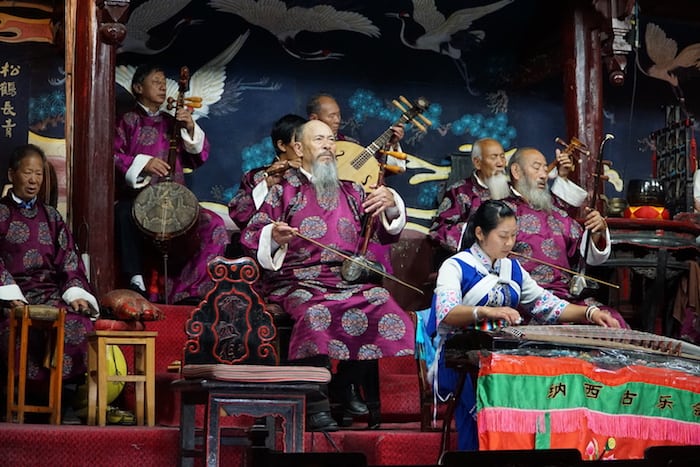 Naxi musicians during a show at Naxi Concert Hall – Photo by Matteo Bosi
Naxi musicians during a show at Naxi Concert Hall – Photo by Matteo Bosi
The ethnic Naxi
The Naxi are an ethnicity of Sino-Tibetan origin. They come from the west of the country and settled here when the commercial routes made this area famous for trading and as a stopping point. The Naxi are typically remembered for their religion, architectural style, writing and music. Some experts say that the Bai and Mosuo are ethnic groups original derived from the Naxi. But there are multiple differences between the Bai and Naxi, to the point that the Chinese government recognizes them as two separate ethnic groups. On the other hand, the Mosuo, who in recent years have become more famous for their matriarchal system that’s still in use, are considered a branch of the Naxi. The largest concentration of the Mosuo lives on the banks of Lake Lugu.
The Naxi are also a people of matriarchal lineage, but one that is much more integrated and assimilated to the Han customs. Nevertheless the Naxi women are still known for their vigor and stubbornness: they are tireless workers because they have always been raised to support the family, and to this day maintain a certain influence over family decisions.
The religion of the Naxi is called Dongba; today it battles for survival and the traditional rites practiced by Dongba shamans are often portrayed as local folklore. Many of the Naxi converted to Tibetan Buddhism, which has the same moderate and respectful style that is the nature of the Dongba religion.
The extraordinary Dongba writing is the only pictography still in use, though it’s slowly slipping into oblivion. It has many strokes in common with the Egyptian and Mayan systems. Together with the phonetic alphabet called Geba, it was the writing system historically used by the Naxi.
When it comes to Naxi architecture which has been spoken about above, it has actually integrated Han characteristics, far more then the Bai of Dali. What has truly remained one of a kind and is something you absolutely should not miss, is Naxi music (see below).
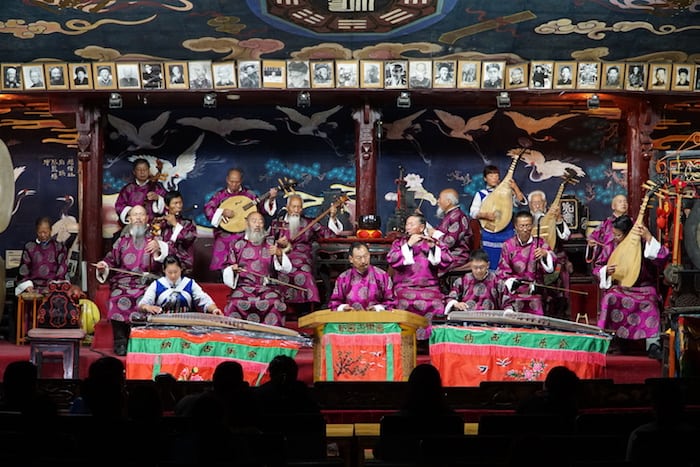 The Naxi orchestra – Photo by Matteo Bosi
The Naxi orchestra – Photo by Matteo Bosi
Not to miss
Whenever you find yourself in Lijiang, even if it’s just for a night, you can’t miss the Naxi music show held at the Naxi Concert Hall (the small theater on Dong Da Jie, not the large modern concert hall outside the historic center!). For several years and thanks to the brilliant intuition of Xuan Ke, the old Naxi musicians keep alive and spread the tradition of their music and typical instruments. At the Naxi Concert Hall you can attend, every evening at 20, an orchestral concert with some twenty elements, of which at least 90% are white-haired and shriveled, but perfectly capable of entertaining an audience for more than an hour. And all this presented in two languages!
Naxi music tells stories of everyday life and produces shrill sounds quite different than what we are used to. A ticket costs 150 Yuan, but it all goes to keep the theater, its musicians and the whole initiative going, which has to compete with the more commercial modern theater, the one I mentioned before. There you’ll find dances in fake traditional costumes and music blasting at full volume from technological amplifiers.
My experience attending the show was unique: besides saving us from a torrential downpour, the Naxi music even won over my sixteen month old daughter, who stood in her little chair, enchanted by the percussive beats and the trills of the bells.
If there’s something else you’d like to know, leave me a comment below!
Happy travels to the magic of Lijiang!



